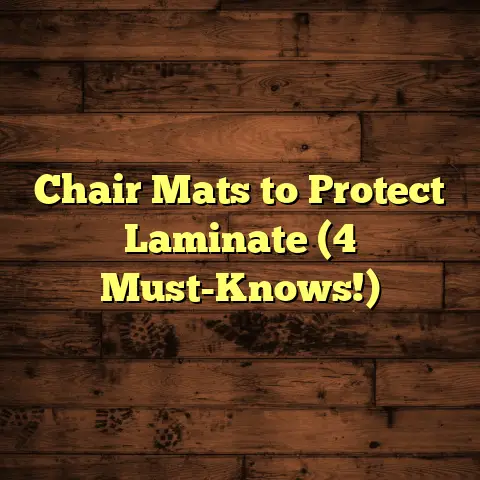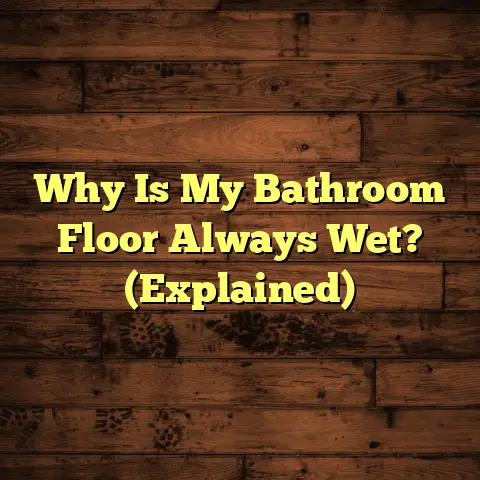Tool to Remove Hardwood? (3 Mistakes to Avoid!)
I’ve seen it all, from flawless hardwood installations to… well, let’s just say some pretty creative removal attempts.
There’s nothing quite like the feel of real hardwood underfoot.
The smooth, polished surface of maple, the rustic charm of oak, the exotic grain of Brazilian cherry – each species brings a unique warmth and character to a home.
It’s no wonder hardwood remains a top choice for homeowners seeking a touch of elegance and durability.
But let’s face it, sometimes hardwood needs to go.
Maybe you’re renovating, dealing with water damage, or simply craving a fresh new look.
Whatever the reason, removing hardwood flooring can be a real beast if you’re not prepared.
Trust me, I’ve seen homeowners wrestle with crowbars, snap blades, and create more of a demolition derby than a clean removal.
That’s why I’m here to guide you through the process, sharing my expertise and helping you avoid some common pitfalls.
Ready to learn the secrets to successful hardwood removal? Let’s dive in!
Understanding the Tools Available for Hardwood Removal
Okay, let’s talk tools.
You wouldn’t try to paint a house with a toothbrush, right?
Same goes for hardwood removal.
Having the right tools can make the difference between a smooth, efficient job and a frustrating, back-breaking ordeal.
Here’s a rundown of some common contenders:
Pry Bars: These are your trusty workhorses.
They come in various sizes and shapes, perfect for getting under those stubborn boards and levering them up.-
Crowbars: Similar to pry bars, but usually larger and heavier, offering more leverage for tougher jobs.
-
Floor Scrapers: These specialized tools have a wide, flat blade designed to slide under flooring and lift it away from the subfloor.
Oscillating Tools: These versatile power tools can be fitted with various blades for cutting, scraping, and sanding.
They’re particularly useful for removing glue-down hardwood.-
Hammer: A good old-fashioned hammer is essential for tapping tools into place and breaking apart stubborn boards.
-
Chisel: Useful for getting under edges and removing small pieces of flooring.
Hand Tools vs. Power Tools
Now, the big question: should you go the hand tool route or unleash the power of machines?
Here’s my take:
Hand Tools:
-
Pros:
- More control and precision.
- Less likely to damage the subfloor.
- Quieter and less disruptive.
- More affordable.
-
Cons:
- More physically demanding.
- Slower process.
- Requires more elbow grease.
Power Tools:
-
Pros:
- Faster and more efficient.
- Less physically demanding.
- Can tackle tougher jobs.
-
Cons:
- Less control and precision.
- Higher risk of damaging the subfloor.
- Noisier and more disruptive.
- More expensive.
Honestly, it depends on the size and scope of your project, your budget, and your personal preference.
For small areas or delicate work, hand tools are your best bet.
For large areas or stubborn flooring, power tools can save you a lot of time and effort.
Choosing the Right Tool for the Job
Here’s where things get specific.
The type of hardwood flooring you’re dealing with will heavily influence your tool selection.
Nail-Down Hardwood: This is the most common type, where the boards are nailed directly to the subfloor.
A pry bar and hammer are your go-to tools here.- Technique: Slide the pry bar under the edge of a board, use the hammer to tap it into place, and then gently lever the board upwards, working your way along its length.
Glue-Down Hardwood: This type is glued directly to the subfloor, making removal a bit more challenging.
An oscillating tool with a scraper blade or a floor scraper are your best bets.- Technique: Use the oscillating tool to cut through the adhesive, working in small sections.
For floor scrapers, apply firm, even pressure to slide the blade under the flooring.
- Technique: Use the oscillating tool to cut through the adhesive, working in small sections.
Floating Hardwood: This type isn’t directly attached to the subfloor.
Instead, the boards are connected to each other, forming a “floating” surface.
A pry bar and hammer can usually do the trick here.- Technique: Start at one edge of the room and gently pry up the boards, separating them from each other.
Here’s a handy table to summarize:
Texture Matters
Don’t underestimate the importance of texture!
The finish on your hardwood can actually affect the removal process.
For example, a high-gloss finish can be slippery, making it harder to get a good grip with your tools.
A textured or distressed finish, on the other hand, might provide more traction.
Consider wearing gloves with a good grip to improve your control and prevent slippage.
I’ve worked on floors where the finish was so smooth, my pry bar kept sliding off!
It was a real pain.
A little bit of grip can make a big difference.
The Three Mistakes to Avoid When Removing Hardwood
Alright, now that we’ve covered the tools, let’s talk about the common mistakes that can turn your hardwood removal project into a disaster.
Trust me, I’ve seen these mistakes firsthand, and they’re not pretty.
Mistake #1: Not Preparing the Area Properly
This might seem obvious, but it’s amazing how many people skip this crucial step.
Before you even think about picking up a tool, you need to clear the space.
That means removing all furniture, rugs, and any other obstacles.
Why is this so important?
- Safety: A cluttered workspace is a recipe for accidents.
You’re more likely to trip, fall, or bump into something, potentially injuring yourself or damaging your surroundings. - Efficiency: Trying to work around furniture and other obstacles will slow you down and make the job much more difficult.
- Damage Prevention: You don’t want to accidentally scratch or dent your furniture while you’re wrestling with hardwood boards.
I remember one time, a homeowner tried to remove hardwood in a room that was still half-full of furniture.
It was a complete mess!
He kept banging into things, scratching the walls, and nearly tripping over a coffee table.
He ended up spending more time moving furniture than actually removing flooring.
My advice: Take the time to properly prepare the area.
It will save you time, frustration, and potential damage in the long run.
Mistake #2: Choosing the Wrong Tool
I touched on this earlier, but it’s worth emphasizing.
Using the wrong tool for the job is a surefire way to make your life difficult.
Imagine trying to remove glue-down hardwood with just a pry bar and hammer.
You’d be there for days, chipping away at the adhesive and probably damaging the subfloor in the process.
Or, picture using a heavy-duty floor scraper on delicate, nail-down hardwood.
You could easily gouge the subfloor or even crack the boards.
Here’s the deal: Each type of hardwood flooring requires a specific set of tools and techniques.
Using the wrong tool can lead to:
- Damage to the Flooring: You could splinter the boards, crack the finish, or even break them apart.
- Damage to the Subfloor: Gouging, scratching, or otherwise damaging the subfloor can create extra work and expense.
- Frustration and Fatigue: Using the wrong tool will make the job much harder and more time-consuming, leading to frustration and fatigue.
I once saw a homeowner trying to remove nail-down hardwood with an oscillating tool.
He was essentially cutting the boards into tiny pieces, creating a huge mess and making it much harder to remove the nails.
It was painful to watch!
My advice: Do your research and choose the right tools for the type of hardwood flooring you’re dealing with.
Mistake #3: Ignoring Safety Precautions
Hardwood removal can be a physically demanding and potentially hazardous task.
Ignoring safety precautions is a recipe for injury.
Here are some common hazards to be aware of:
- Sharp Edges: Hardwood boards can have sharp edges and splinters, which can easily cut or puncture your skin.
- Heavy Lifting: Lifting and moving large pieces of hardwood can strain your back and other muscles.
- Dust and Debris: Hardwood removal can generate a lot of dust and debris, which can irritate your eyes, skin, and respiratory system.
That’s why it’s essential to wear the proper safety gear, including:
- Gloves: Protect your hands from cuts, splinters, and abrasions.
- Knee Pads: Protect your knees from pain and discomfort while working on the floor.
- Safety Glasses: Protect your eyes from dust, debris, and flying objects.
- Dust Mask or Respirator: Protect your lungs from dust and other airborne particles.
I always wear gloves, knee pads, and safety glasses when I’m removing hardwood.
It might seem like overkill, but it’s better to be safe than sorry.
I remember one time, I was removing hardwood without wearing gloves, and I got a nasty splinter in my finger.
It was painful and annoying, and it took me several minutes to get it out.
My advice: Don’t take shortcuts when it comes to safety.
Wear the proper gear and be aware of your surroundings.
Best Practices for Successful Hardwood Removal
Okay, now that we’ve covered the mistakes to avoid, let’s talk about the best practices for successful hardwood removal.
Here’s a step-by-step guide to help you get the job done right:
-
Prepare the Area: As we discussed earlier, clear the space of all furniture, rugs, and other obstacles.
-
Gather Your Tools: Make sure you have the right tools for the type of hardwood flooring you’re dealing with.
-
Protect Yourself: Wear gloves, knee pads, safety glasses, and a dust mask or respirator.
-
Start at One Edge: Begin at one edge of the room and work your way across.
-
Use the Right Technique: Use the appropriate technique for the type of hardwood flooring you’re dealing with (pry bar for nail-down, oscillating tool for glue-down, etc.).
Be Patient: Don’t try to rush the process.
Take your time and work carefully to avoid damaging the flooring or the subfloor.-
Dispose of the Debris: As you remove the hardwood, collect the debris and dispose of it properly.
Here are some additional tips to keep in mind:
- Work in Small Sections: Don’t try to remove too much flooring at once.
Work in small sections to maintain control and avoid fatigue. - Use a Helper: If possible, enlist the help of a friend or family member.
Having an extra pair of hands can make the job much easier. - Take Breaks: Hardwood removal can be physically demanding, so take breaks as needed to avoid fatigue and injury.
- Deal with Stubborn Boards: If you encounter a stubborn board, don’t force it.
Try using a different tool or technique, or apply a little heat to soften the adhesive.
Dealing with Adhesive Residue:
Glue-down hardwood can leave behind a stubborn adhesive residue.
Here are a few ways to remove it:
- Scraping: Use a floor scraper or a putty knife to scrape away the residue.
- Solvent: Apply a solvent-based adhesive remover to soften the residue and make it easier to scrape away.
- Heat Gun: Use a heat gun to soften the adhesive and make it easier to scrape away.
Important Note: Always follow the manufacturer’s instructions when using solvents or heat guns.
Conclusion
So, there you have it – my comprehensive guide to hardwood removal!
I hope this article has given you the knowledge and confidence you need to tackle your own hardwood removal project.
Remember, the key to success is to:
- Choose the right tools.
- Prepare the area properly.
- Take safety precautions.
- Be patient and methodical.
With a little bit of planning and effort, you can remove your old hardwood flooring and create a fresh new look for your home.
Good luck, and happy DIY-ing!





